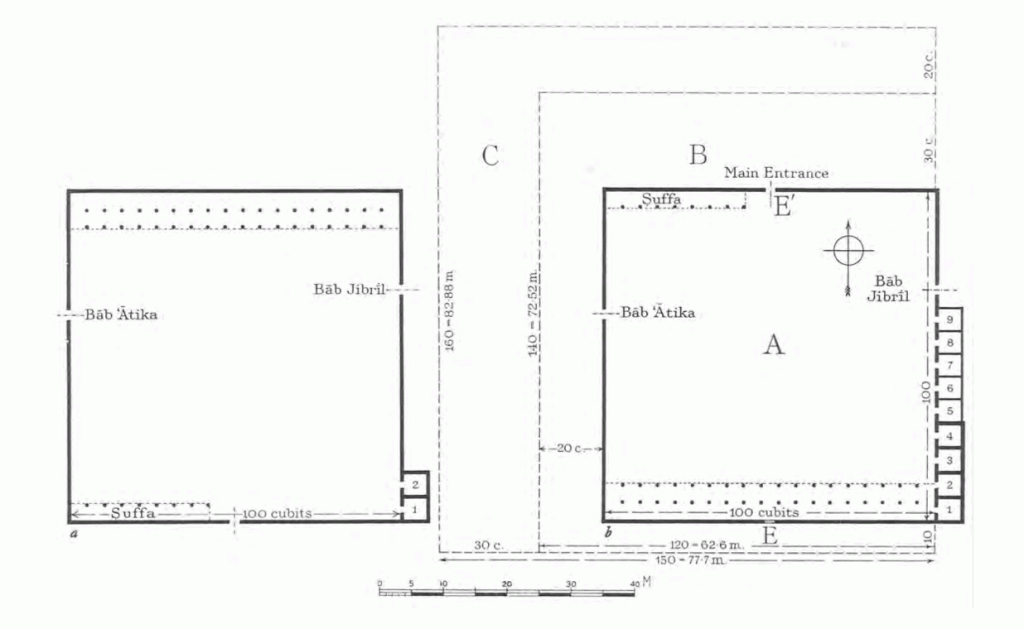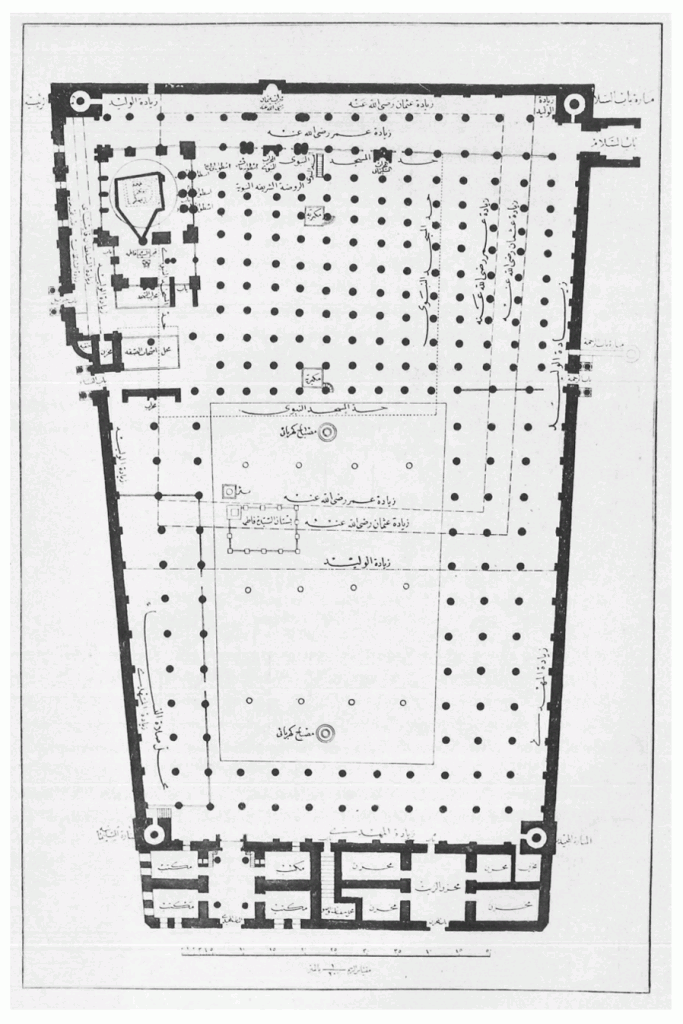 Medina: Muhammad’s House/Mosque, from KAC Creswell Early Muslim Architecture, (New York: Hacker Art Books, 1979)
Medina: Muhammad’s House/Mosque, from KAC Creswell Early Muslim Architecture, (New York: Hacker Art Books, 1979)
 The plan of the enlarged Mosque of Muhammad in The Medina, from Jean Sauvaget, La mosquée omeyyade de Médine (Paris: Vanoest, 1947)There is a fundamental transition in the theological concepts of space in the history from paganism to Abrahamic religions. In fact, the Latin paganus, in its early Christian adoption, has an anti-urban connotation, which is inherited in the original meaning of the word as “country dweller” or “not of a city”. Indeed, the historical association of the Abrahamic religions’ theology with the idea of city, in opposition to paganism, has led to a specific interpretation of urban form, in which the concepts of religion, sovereignty and the city are intertwined. The exclusive archetype of the temple as the dwelling place of gods or sacred spirits, has been transformed according to the idea of the (holy) city in which the community of believers in the form of citizens manifests the sacred. In the time of Essenes in the mid-second century BC, the first sparkles of an alternative ideology emerged. This minor Jewish sect believed in community life, while they viewed their own community as the true Temple. Thereby the very notion of spiritual temple or celestial temple was formally conceptualised, which became further developed in both Christianity and Islam. It was adopted in Christianity first when Jesus himself was portrayed as the temple in John 2:19, “destroy this temple [Jesus], and in three days I will raise it up”. It becomes very close the Jewish version in Paul in which he identifies the body itself as a “temple of the Holy Spirit” (1 Cor. 6:19), then identifying the temple with each individuals: “Do you know that you are God’s temple and that God’s spirit dwells in you” (1 Cor. 3:16). However, the most explicit, and at the same time concrete, development of this idea occurs at the dawn of the Islamic empire when the Islamic ideology reconstructed the concept of city through the very idea of Medina.
The plan of the enlarged Mosque of Muhammad in The Medina, from Jean Sauvaget, La mosquée omeyyade de Médine (Paris: Vanoest, 1947)There is a fundamental transition in the theological concepts of space in the history from paganism to Abrahamic religions. In fact, the Latin paganus, in its early Christian adoption, has an anti-urban connotation, which is inherited in the original meaning of the word as “country dweller” or “not of a city”. Indeed, the historical association of the Abrahamic religions’ theology with the idea of city, in opposition to paganism, has led to a specific interpretation of urban form, in which the concepts of religion, sovereignty and the city are intertwined. The exclusive archetype of the temple as the dwelling place of gods or sacred spirits, has been transformed according to the idea of the (holy) city in which the community of believers in the form of citizens manifests the sacred. In the time of Essenes in the mid-second century BC, the first sparkles of an alternative ideology emerged. This minor Jewish sect believed in community life, while they viewed their own community as the true Temple. Thereby the very notion of spiritual temple or celestial temple was formally conceptualised, which became further developed in both Christianity and Islam. It was adopted in Christianity first when Jesus himself was portrayed as the temple in John 2:19, “destroy this temple [Jesus], and in three days I will raise it up”. It becomes very close the Jewish version in Paul in which he identifies the body itself as a “temple of the Holy Spirit” (1 Cor. 6:19), then identifying the temple with each individuals: “Do you know that you are God’s temple and that God’s spirit dwells in you” (1 Cor. 3:16). However, the most explicit, and at the same time concrete, development of this idea occurs at the dawn of the Islamic empire when the Islamic ideology reconstructed the concept of city through the very idea of Medina.
Islam is a religion that is oriented towards community. The effect of this orientation is translated in the concept of ummah (community of faithful), with which the Muslim society is identical. This concept is a divine commandment and a definite mission assigned by God, who commands Muslims to be a social totality, the ummah. Since the very beginning of the formation of the Islamic state, in a very political move, the concept of ummah was delegated to abandon the relationship to the land, which is in the idea of nation. The community of faithful, as it is described in the Quran, is the Islamic society that lives under an Islamic state, whom their only unifying principle is the faith in the Islamic ideology and its political manifestation. The faith here arrives as the decisive factor to mark the believers from non-Muslims. The faithful bodies therefore are granted a great privilege to enter the sacred place. The eternal paradisiacal house of mankind, which was abandoned due to the original sin, once again, was reconstructed in a the form of terrestrial paradise; a particular understanding of city which is theorised, formed and constructed according to the deep meanings of the term Medina.
Etymologically the term Medina is derived from an Akkadian root dinu or denu. Both stand for law, right and judgment. It appears as din in Aramaic, which is where the Hebrew and Arabic din originate from. In Aramaic, din literally means law (as noun), and to rule (as verb). In its very exclusive occurrence it precisely appears as political. This is borrowed in Hebrew and Arabic and expressed in two fundamental words, din, as judgment/law, and medina, as city. Only in modern times medina came to be used to describe a “sovereign state”.
There is an interesting exchange between the Arabic, Hebrew and Persian meanings of din. The second root of din is in the Indo-European dheye or “to see”. It appears in the Avestan term daena as “insight” or “religion” and finally in the word din in Persian, which literally stands for religion. These three meanings of din: law, the political and religion, are bound together in constructing the deep meaning of the word medina, in which marks the ideological foundation of the concept of the city in the exchange and collapse of the ideas and beliefs in the history of its evolution. The term renders a political power associated with a territorial dimension. In fact, medina can be understood as a “space of sovereignty”, while it affirms a form of settlement, which is fundamentally shaped, defined and controlled by a theological political power.
The term medina, therefore, is employed in early Islam to differentiate between the other terms, which were already used to describe towns, villages and settlements, such as wādī, bilād, qariyya, diyār, dār. The emergence of the term medina in the early Islamic years coincides with the formation of an ideological state, where the spatial, juridical and religious dimensions of the term have bound together in the reconstruction of the concept of city. The Islamic medina, in fact, is the restoration of the idea of “terrestrial paradise.” This ideological form of city found its utmost spatial demonstration in foundation of the very first Islamic city, the Medina of the Prophet.
The Medina
The earliest example of the realisation of this very particular idea of city happened in 622 AD, when the prophet Mohammad, together with a group of faithful people, who had just converted to Islam, moved from Mecca to a place called Yathrib, later on named as the city of “The Medina”. The land was dwelled by few Jewish-Arab clans who moved around the year 300 AD to the western part of the Arabian Peninsula. As it has been recorded in the historical documents, there was no formal settlement in the form of a city; a constellation of inhabited oases, dispersed cultivated lands around the wells. Mohammad moved there to build up the first Islamic sovereign state and therefore the first Islamic city.
By the order of Mohammad, an enclosure was erected in a place, which was chosen by performing a specific ritual, known later as the mosque of Muhammad. It was built as a squared plan of 100 cubits (51 meters) long in each direction, bounded with a wall of 7 cubits (3.5 meters) high. At the first stage when Muslims were praying towards Jerusalem, they built a roofed structure, partly supported by two rows of columns. Here the prayers could be practised and common meetings would take place. By the time of the changing of the direction of the qibla, in 624 A.D., towards Mecca, the roofed space was extended to the southern side of the building. Two rows of typical houses were built in the other two sides to host the family of the prophet and also those who accompanied him (the faithful group from Mecca). The construction of the closed houses started from two units in the Eastern side; the residence of Mohammad. At this time, in the southern side, a roofed platform (suffa) was erected for the companions. In fact the latter component was an open plan, extendible, to house the core body of the Islamic society in that time.
This very primitive structure is mostly identified as the house or mosque of Mohammad, but in fact, it was an inhabitable place to exclusively mark the core political body of an Islamic state; the Prophet, the Sovereign ruler, and the community of faithful, set in a territorial dimension. It is the most characteristic, if not the only characteristic, requirement of early Muslim political space: “a large enough space for the whole body of the faithful who find themselves in any place.”[1]1. Oleg Grabar, “The Architecture of the Middle Eastern City, from past to present: The case of the Mosque”, in I.M. Lapidus (ed.), Middle Eastern Cities, (Berkeley: University of California Press, 1969) The city, indeed, is the spatial apparatus, for inhabiting the political bodies. The act of exclusion (of non-Muslims) found its spatial dimension not only in the form of a carefully planned enclosure, but also in placing the bodies of the faithful as the border itself. This spatial organization later on became formalised in the foundation of the earliest Islamic cities, such as Basra, Kufa and Wasit.



